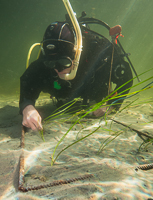ABSTRACT
More than 50% of eelgrass habitats have disappeared from the Swedish NW coast in the last 30 years. Restoration is being proposed to assist recovery but little is known regarding methods suitable under Scandinavian conditions; e.g. short growing seasons and scouring by ice. In the present study we evaluated different restoration methods using shoots and seeds in a Swedish fjord and assessed if eelgrass could be successfully transplanted between sites with different depth and exposure.
This study demonstrates that both shoot and seed methods can be successfully used to restore eelgrass at this latitude. Survival and growth of unanchored single shoots, transplanted without sediment in shallow habitats (1.0–1.5 m) was very high (500% increase in shoot density after 14 months). This restoration method showed 2–3.5 times higher growth rate and was 2–2.5 times faster compared with shoots anchored in the sediment and shoots transplanted in sediment cores, respectively, and is recommended for shallow habitats in Sweden.
Growth within deeper habitats (3.0–4.5 m) was substantially lower (40% loss to 50% increase) due to light limitations and high winter mortality. Restoration using seeds distributed from mesh-bags showed very low seedling establishment rates (approximately 1%) making this method less cost-effective than transplanting single shoots in shallow habitats. However, growth of seedlings was high and this method is recommended for deep habitats with soft sediment where shoot transplantation is difficult.
Despite dramatic differences in eelgrass morphology between habitats with different depth and exposure, all shoots within a planting site had the same morphology at the end of the study, independent of origin. A baseline genetic survey supported that the observed changes in morphology of transplants were due to a plastic response, suggesting that donor populations do not have to exactly match the morphology of the plants targeted for restoration.











